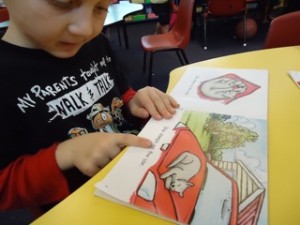 Travis is almost 6 years old and is learning to read.
Travis is almost 6 years old and is learning to read.
As he has an alternating vertical squint and nystagmus, Travis has had to develop some skills and strategies to help him track from left to right.
Alex describes how she has worked alongside Travis to support him in gaining these new skills. She also gives an overview of the teaching strategies she uses to support an emergent reader.
Developing reading skills
The children sat on the mat in front of the teacher while she showed them the book and read the story to them.
- First, they talked about the cover and what the story may be about.
- Secondly, the pictures were discussed before the text was read in order to help with prediction of the content.
- Finally, before each page was turned the children were asked to predict what was going to happen next.
- Each child was given a copy of the book and told to read the story with a buddy.
I was Travis’s buddy and, as you can see in figure 1, Travis is reading the story to me. Travis has an alternating vertical squint and nystagmus so finger pointing helps him to make sure that he tracks along the line and reads every word.
Travis initially didn’t notice the words under the picture on the right hand page.
I directed Travis to the words under the picture as is seen in figure 2.
When he had read the words I asked Travis what the girl in the picture was doing and where she would be going to next.
At first he shook his head indicating that he didn’t know where she was going to go.
Then Travis turned the page to help him discover what the girl was going to do.
Where to next?
Continued use of tracking games to reinforce and to stimulate eye directionality and concept understanding eg. CLEARVIEW, Pre-Reading Perception skills by John Baguley; mazes, picture sequencing.
Travis is having regular individual reading help with a teacher’s aide. He will be encouraged to move from finger pointing to the use of a mask/ line guide to help him keep his place.
Word cards will be made of the most common words in his reading books. These will be used for matching, word recognition and story writing.
Learning adaptations
Adaptions to environment: A table at the back of the classroom was set up for Travis with the resources that were being used with him.
This enables whoever is working with Travis to work one-on-one without interrupting the rest of the class. The class computer accessibility option was adjusted to suit Travis’s vision.
Teaching strategies
A regular routine was established for Travis to work in class with a teacher aide for part of the morning. Constant repetition of strategies with the various resources is used daily.
- Always worked from left to right.
- To reinforce the need to track from left-right, alphabet letters were first used on the floor to form long lines and then sequenced in rows on the small whiteboard.
- Tracking puzzles were used for variety, to stimulate interest and to reinforce left to right directionality.
- Stickers were used in a workbook and Travis placed them along a line going from left to right.
- Short rhyming CVC words were written with the first letter of the word in one colour and the last letter in another. This was to help Travis to see that words had a beginning and end.
- Bean bags- these were thrown for Travis to catch to help improve his focus.
Resources
Resources used were as above plus the alphabet games that his class teacher already had. Paper copies of puzzles were enlarged to Print size N16.
- Magnetic alphabet letters and a small white board.
- Tracking puzzles- The Look Book, Iris Hambling
- Peg board with pegs
- Felt pens
- Stickers
- Bean bags
Useful links
- Vision and Reading, Children’s Vision Information Network.
- Instructional strategies – Pathways to literacy developed by TSVBI and Perkins School for the Blind.
More information
If you would like to find out more information about this subject, email us at BLENNZ Online.
We will link you up with either the author of this post or another BLENNZ colleague with whom you can continue your conversation.


